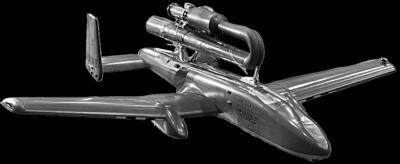Mon, Mar 11, 2024
UAV Industry Dusting Off Sidelined Designs in Search of Smaller, Lighter Powerplants
The legendary sound of the old V-1 of WWII fame is back, except this time it's powering an...uncrewed, combat-ready UAV.

Okay so most everything about it is the same when it comes to the broad strokes, but in this case the simple fact is that the autonomous aspects of drones have finally caught up to the point where having a super cheap, simplistic jet engine makes sense. North American Wave Engine Corporation got some civilian attention with the publication of its civilian-spec pulsejet engines, using their J-1 engine atop a very familiar silhouette.
Their demonstrator, the Scitor, cuts a very close approximation of the A-10 Thunderbolt in form, with a very ungainly contraption bolted atop its fuselage. It offers the same tail, wings, and fuselage design seen on the classic groundpounder at a 100-lb gross weight and 20-lb payload. That's the good ol' pulsejet, resurrected in all its 1940's design glory once again. The J-1 engine demonstrated offers 55 pound-feet of thrust while only taking up 18 lbs of weight aboard the aircraft. If that power to weight ratio wasn't enough to pique attention, it's one omnivorous little piece of equipment, running on standard av and mogas, e85, and jet fuels of every stripe. Where it differs quite a bit from the vintage examples of the breed is fuel consumption: 2 pounds an hour, much better than the old V-1 buzz bombs used to get. That comes courtesy of the newfangled digital ECUs keeping everything nicely optimized throughout the flight. Wave says it's ideal for a "high-speed UAV up to 200 lbs gross weight".
Their recent demonstration should help advertise its availability to an industry, with only 12 weeks of lead time required for each J-1. A larger, apparently developing model will be the K-1, a scaled up version offering 220 lbf of thrust.
It's a fun thing to see in the industry today, as aeronautical engineers look to past ideas that were once cast aside for renewed possibility. Newer hydrogen fuels might see the return of 2-stroke piston engines, now the pulsejet comes back from the dead too. The uncrewed autonomous aircraft market is hungry for lightweight, high-output powerplants, and thanks to the ever-decreasing costs of the electronics underpinning their operations, the market is even willing to play with engines that would once have been far too short-lived to consider in a weapon program today. Wave is hungry for business, so the industry will likely see some smaller UAV developers roll out some very intriguing new designs with a J-1 as their core.
More News
Aero Linx: International Federation of Airworthiness (IFA) We aim to be the most internationally respected independent authority on the subject of Airworthiness. IFA uniquely combi>[...]
Ultrahigh Frequency (UHF) The frequency band between 300 and 3,000 MHz. The bank of radio frequencies used for military air/ground voice communications. In some instances this may >[...]
A Few Questions AND Answers To Help You Get MORE Out of ANN! 1) I forgot my password. How do I find it? 1) Easy... click here and give us your e-mail address--we'll send it to you >[...]
From 2019 (YouTube Edition): Learning To Paint Without Getting Any On Your Hands PPG's Aerospace Coatings Academy is a tool designed to teach everything one needs to know about all>[...]
Also: Sustainable Aircraft Test Put Aside, More Falcon 9 Ops, Wyoming ANG Rescue, Oreo Cookie Into Orbit Joby Aviation has reason to celebrate, recently completing its first full t>[...]
 ANN's Daily Aero-Linx (05.06.25)
ANN's Daily Aero-Linx (05.06.25) ANN's Daily Aero-Term (05.06.25): Ultrahigh Frequency (UHF)
ANN's Daily Aero-Term (05.06.25): Ultrahigh Frequency (UHF) ANN FAQ: Q&A 101
ANN FAQ: Q&A 101 Classic Aero-TV: Virtual Reality Painting--PPG Leverages Technology for Training
Classic Aero-TV: Virtual Reality Painting--PPG Leverages Technology for Training Airborne 05.02.25: Joby Crewed Milestone, Diamond Club, Canadian Pilot Insurance
Airborne 05.02.25: Joby Crewed Milestone, Diamond Club, Canadian Pilot Insurance



